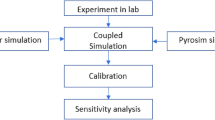Abstract
The simulation model Tunev(tunnel evacuation) was developed for people’s evacuation in tunnel fire. It contains simple database of the people’s behavioral reaction and structure characteristic parameters of tunnel fireproofing. The model can be used to calculate the total evacuation time in various scenes when fire occurs in the different locations of the tunnel. Combined with fire simulation soft ware CFD-POENICS3.5, Tunev model can be used to calculate the fire danger coming time; by comparing with these two kinds of time, it can be used to assess the safety of the evacuation, and the evacuation process also have a dynamic demo. The simulation results show that the Tunev model can be used to predict the reliability of safe evacuation for people in tunnel fire and provide references for people’s safe escape scheme. Some relevant concepts of the model were described and an evacuation simulation of a typical tunnel case, i. e. Xuefeng Mountain Tunnel was performed by using this model. And the model’s validation and actual application were also described.
Similar content being viewed by others
References
XU Gao. Simulation model for crowd evacuation based on agent technology[J]. Journal of Southwest Jiaotong University, 2003, 38(3): 301–303. (in Chinese)
HU Zhong-ri. The current situation and development tendency of the fire evacuation[J]. Fire Science and Technology, 2001, 11(6): 6–7. (in Chinese)
Gwynne S, Galea E R, Owen M, et al. A review of the methodologies used in evacuation modeling [J]. Fire and Materials, 1999, 23(6): 383–388.
Japan Construction Department. The building synthetic fire prevention design[M]. SUN Jin-xiang, et al translate. Tianjin: Tianjin Science and Technology Translation Press, 1994.
Purser D A. Bensilum M. Quantification of behaviour for engineering design standards and escape time calculations[J]. Safety Science, 2001, 38: 157–182.
Bari S, Naser J. Simulation of smoke from a burning vehicle and pollution levels caused by traffic jam in a road tunnel[J]. Tunnelling and Underground Space Technology, 2005, 20: 281–90.
Michael M, Laura C. A comparison of two methodologies in hazard fire egress analysis[J]. Fire and Materials, 1999, 23(6): 326–330.
Lo S M, Fang Z. A spatial-grid evacuation model for buildings[J]. Journal of Fire Science, 2000, 18(5): 376–394.
WANG Zhi-gang, ZHANG Ying-hua, BI Shao-ying, et al. Using computer model to evaluate the fire safety design of actual building[J]. Fire Science and Technology, 2001, 3(2): 6–10. (in Chinese)
Hadjisophocleous G V, Proulx G, LIU Q. Occupant evacuation model for apartment and office buildings [R]. Canada Institute for Research in Construction, 1997.
John L. Human behavior in fire: the development and maturity of a scholarly study area[C]// Human behavior in fire proceedings of the first international symposium. Northern Ireland: University of Ulster, 1998.
Fraser-Mitchell J N. Modeling human behavior within the fire risk assessment tool CRISP[J]. Fire and Materials, 1999, 23(6): 349–355.
ZHANG Zhi-dao. Fire disaster ventilation of highway tunnel[J]. Modern Tunnel Technology, 2003, 40(1): 36–37. (in Chinese)
HUO Ran, HU Yuan, LI Yuan-zhou. Safety engineering introduction [M]. Hefei: China Science and Technique University Press, 1999: 131–135. (in Chinese)
HUO Ran, JIN Xu-hui, LIANG Wen. Simulation analysis for people’s escape in large public building fire[J]. Fire Safety Science, 1999, 8(2): 8–14. (in Chinese)
YAN Zhi-guo, YANG Qi-xin. Study on temperature field distribution in Qinling road tunnel by fire experiments[J]. Underground Space, 2003, 23(2): 191–195. (in Chinese)
ZENG Yan-hua, HE Chuan, GUAN Bao-shu. Study on simulation of temperature field in tunnel during fire[J]. Underground Space, 2004, 24(1): 69–71. (in Chinese)
Bendelius A G. Tunnel fire and life safety within the world road association (PIARC) [J]. Tunneling and Underground Space Technology, 2002, 17(5): 159–161.
Jojo S M, Chow W K. Numerical studies on performance evaluation of tunnel ventilation safety systems [J]. Tunnelling and Underground Space Technology, 2003, 18: 435–452.
Author information
Authors and Affiliations
Corresponding author
Additional information
Foundation item: Project (20033179802) supported by the Science and Technology Program of China Western Transportation Development
Rights and permissions
About this article
Cite this article
Yang, Gs., Peng, Lm., Zhang, Jh. et al. Simulation of people’s evacuation in tunnel fire. J Cent. South Univ. Technol. 13, 307–312 (2006). https://doi.org/10.1007/s11771-006-0130-5
Received:
Accepted:
Issue Date:
DOI: https://doi.org/10.1007/s11771-006-0130-5




